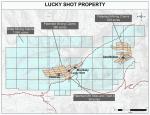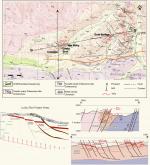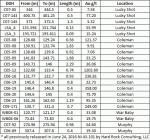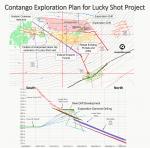
Contango ORE, Inc. (“CORE” or the “Company”) (OTCQB: CTGO) is pleased to announce that it has completed the purchase of 100% of the outstanding membership interests (the “Interests”) of Alaska Gold Torrent, LLC, an Alaska limited liability company (“AGT”), from CRH Funding II PTE. LTD, a Singapore private limited corporation (“CRH”). AGT holds rights to the Lucky Shot Mine and related mining claims (the “Lucky Shot Project”) located in the Willow Mining District about 75 miles north of Anchorage, Alaska. The Lucky Shot Mine historically produced 252,000 oz of gold from 169,000 tons of ore (Stoll, 1997) indicating an average head grade of 1.5 oz/ton (1.6 oz/tonne). Historic production from the Willow district is estimated at 610,000 ounces of gold from grades between 30 and 60 g/t.1 A recent pre-feasibility study and resource estimate was completed in 2016 by Hard Rock Consulting on behalf of Miranda Gold and Gold Torrent Inc. which included measured and indicated resources containing 121,500 ounces grading 18.3 g/t using a 5g/t cut-off grade and a $1265 gold price.2 Below is a summary of the business terms for the acquisition followed by a more detailed description of the assets and the opportunity for CORE. For further information, please visit our website at www.contangoore.com.
This press release features multimedia. View the full release here: https://www.businesswire.com/news/home/20210825005134/en/
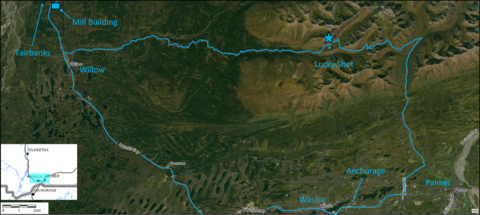
Figure 1 - Map showing location of the Lucky Shot Project (Graphic: Business Wire)
Rick Van Nieuwenhuyse, the Company’s President and CEO commented: “Although it is full steam ahead for the Manh Choh project based on the latest Kinross guidance, the Lucky Shot project represents an exciting opportunity to add significant additional value for Contango shareholders and marks a new focus for the Company. The historic Willow Mining District consistently produced high-grade gold from free-milling, low angle quartz veins averaging between 30 and 60 g/t (1 to 2 opt) and measuring 1 to 5 meters thick (3 to 15 ft). The property is road accessible and has excellent infrastructure. Our plan is to re-establish access to drill the down-dip extension of the Lucky Shot and Coleman mines, which historically produced over 250,000 ounces of gold from ore grading 1.6 oz/tonne (40g/t).
Once access is established, we plan to refurbish the underground workings, where the granodiorite host rock generally needs little support. We then plan to construct 600 meters (~2,000’) of new 3mx4m (10’x12’) drift paralleling the vein, followed by ~2,400 meters (~7,800’) of underground diamond drilling to define a new resource. The Lucky Shot and Coleman veins have only been mined a short distance down dip (~200 meters or 660‘). These type of mesothermal veins systems typically extend for kilometers down dip. The Company sees the potential to develop significant gold resources of high-grade gold vein along the + 1.6 km (~1mile) known Coleman-Lucky Shot-War Baby trend by drilling down dip of the areas historically mined. Furthermore, drilling by Full Metals Minerals between 2005 and 2009 on the Murphy Zone, approximately 600 meters (~2000’) to the east of the War Baby historic mine, intersected a 1-meter vein sample running 54.6 g/t suggesting that mineralization may continue further east from the three developed mines – Coleman/Lucky Shot/War Baby. Contango is well positioned, with experienced personnel and capital, to explore and expand the historic high-grade resource at Lucky Shot. We feel the exploration potential of the Willow district is excellent, albeit perhaps under-appreciated.”
SUMMARY OF THE TRANSACTION
CORE agreed to purchase the Interests for a total purchase price of up to $30 million. The initial payment at closing to CRH will be $5 million in cash and a $6.25 million promissory note payable by CORE (the "Promissory Note"), with a maturity date of February 28, 2022 (the “Maturity Date”). The Promissory Note is secured by the Interests. If, prior to the Maturity Date, CORE completes a public offering of newly issued CORE common stock and obtains a listing of the CORE common stock on the NYSE American, CORE will pay the Promissory Note through the issuance to CRH of CORE common stock valued at (x) if available, the per share price in the public offering, or (y) the per share price representing a 10% discount to the 30-day volume-weighted average share price as of the Maturity Date. If the public offering is not completed or the CORE Common Stock is not listed on the NYSE American on or before the Maturity Date, CORE will pay the Promissory Note in cash.
In addition to the cash consideration, if production on the Lucky Shot Prospect meets two separate exploration and/or production thresholds, then CORE will pay CRH additional consideration. If the first threshold of (1) an aggregate “mineral resource” equals 500,000 ounces of gold or (2) CORE produces and receives an aggregate of 30,000 ounces of gold (which includes any silver based on a 1:65 gold:silver ratio) is met, then CORE will pay CRH $5 million in cash and $3.75 million in newly issued shares of CORE common stock. If the second threshold of (1) an aggregate “mineral resource” equals 1,000,000 ounces of gold or (2) CORE produces and receives an aggregate of 60,000 ounces of gold (which includes any silver based on a 1:65 gold:silver ratio) is met, then CORE will pay CRH $5 million in cash and $5 million in newly issued shares of CORE common stock. The shares of CORE common stock will be issued based on the 30-day volume weighted average price for each of the thirty trading days immediately prior to the satisfaction of the relevant production goal.
CORE is also committing to spend an aggregate of $10 million prior to the 36th month anniversary of the closing date toward the existence, location, quantity, quality, or commercial value of mineral deposits in, under and upon the Lucky Shot Prospect (“Exploration Expenditures”), with at least $5 million being spent during the first 18 month after the closing date. Further, after CORE has made further exploration, mining, and development expenditures on the Lucky Shot Prospect of at least $5 million (in addition to the $10 million of required Exploration Expenditures described above), CORE will be permitted to assign, and be relieved of, its additional consideration payment obligations under the purchase agreement.
LUCKY SHOT GOLD PROJECT
General
The Lucky Shot property includes 725 acres of patented mining claims and 7,865 acres of State of Alaska mining claims totaling approximately 8,590 acres which cover three former producing gold mines in the Willow Mining District located in south central Alaska (see Figures 1 and 2). The three former mines include the Coleman, Lucky Shot and War Baby mines located on the acquired mineral title. The Coleman, Lucky Shot and War Baby mines are located along a continuous low angle structural zone occupied by a series high-grade quartz vein hosting free gold and minor sulfide and telluride mineralization. The vein and structural corridor are hosted by a granodiorite composition intrusion of Cretaceous age (Lester, 2007).
The Lucky Shot project consists of a mine site located 180 road kilometers (112 road miles) north of Anchorage, Alaska, and a processing site located about 48 road kilometers (30 road miles) west of the mine site (Figure 1). Infrastructure is excellent with road access between the mine site and plant site via unsealed secondary road, sealed 2-lane highway, and the 4-lane Parks Highway connecting Anchorage and Fairbanks.
Geology and Historic Production3
The Willow Creek Mining District is located in the southern Talkeetna Mountains of southcentral Alaska and covers an area of approximately 175 sq. km (68 sq. mi. – see Capps, S.R., 1915). The mining district straddles the margin of a granodiorite batholith that forms the Talkeetna Mountains and is bounded on the south by the Castle Mountain fault system (see Figure 3). Total gold production from the Willow Creek district through 1950 was reported to be 19 metric tonnes or approximately 610,874 troy ounces from ores ranging between 30 and 60 g/t (Harlan, et al., 2017) making it the third largest historic lode gold producing district in Alaska. Production from the Lucky Shot was reported to have been 252,000 oz from 169,000 tons of free-milling ore indicating an average head grade of 1.5 oz/ton (1.6 oz/tonne) (Stoll, 1997), with additional production from the Coleman and War Baby mines. The Lucky Shot vein system was determined to be continuous from the War Baby to the Coleman across the project area – a distance of approximately 1.6 kms (1 mile), with two high-angle faults structures segmenting the vein into three blocks (i.e. the Coleman block, Lucky Shot block and War Baby block). A third fault structure further east was determined to separate the War Baby block from drilling that intersected the vein structure in what is known as the Murphy block – extending the known vein structure another 600 meters (~2000’) further east (see Figure 3). Between the Coleman and War Baby mines the vertical and lateral offset is a few meters up to tens of meters which allowed historic mining to continue across faults in a near-continuous manner. This similar magnitude of vertical and lateral displacement is defined as an oblique-slip fault and is typical of a transpressional structural environment. District geologic mapping (Harlin et al., 2017 and several USGS Reports) show that the Castle Mountain fault is a major regional strike slip fault and that the Hatcher Pass Fault is a sympathetic fault that places a thick section of Cretaceous(?) schists up against a rigid body made up of the late Cretaceous Willow Creek batholith (see Figure 3). The Company believes the contact environment between these two disparate lithologies is an ideal location for low angle, listric fault-controlled quartz vein hosted gold deposits (Groves, D. I. et al, 1997), characteristic of the Willow district.
Coleman-Lucky Shot-War Baby Mines
The three historic mines at the Coleman, Lucky Shot and War Baby properties are controlled by a continuous low angle, listric fault zone occupied by a series of quartz veins and sheared breccia zones from 1 meter wide up to several meters in width. The veins are hosted by a granodiorite composition intrusive rock which is part of the Willow Creek batholith described earlier. The quartz veins are central to a broader alteration zone that extends tens of meters adjacent to the veins and consists of sericite, chlorite, albite, leucoxene, and ankerite/siderite. The quartz veins contain native gold, pyrite, arsenopyrite, tetrahedrite-tennantite, sphalerite, galena, and various telluride minerals (coloradoite and nayagite have been identified – Lester, 2007).
After the mines were shut down in 1942 because of the World War II effort, little happened on the property until the 1980s when Enserch Exploration conducted an extensive exploration program which included soil sampling, drilling, and underground exploration. Ensearch constructed a 457 m (1,500’) exploration adit below the Lucky Shot mine and drilled 11 underground core holes totaling 3,159 m (10,364’) and 7 surface core holes in the Coleman zone totaling 1,488m (4,881’) during the 1984 field season. From 2005-2009 Full Metals Minerals drilled a total of 34,103 meters (111,887’) in 173 core holes from surface along the Coleman-Lucky Shot-War Baby-Murphy trend. In 2016 Gold Torrent Inc. published a pre-feasibility report by Hardrock Consulting LLC based on an assessment of all historic work completed on the property (see Hard Rock Consulting PFS Report June 24, 2016). Figure 4 is a Table of selected drill hole results that demonstrate the exploration potential of the down-dip exploration potential along the 1.6 km (1 mile) Coleman-Lucky Shot-War Baby-Murphy trend (see Hard Rock Consulting PFS Report June 24, 2016).
CORE Exploration Plan
CORE plans to re-establish access to drill the down-dip extension of the Lucky Shot and Coleman mines. The Company plans to either initiate construction of a road from the existing mine access road to the Lucky Shot tunnel entrance (a distance of approximately one quarter mile/400 meters) or extend the Ensearch tunnel to access the same target area from underground. Once access has been established, the Company plans to refurbish the old underground workings, where the granodiorite host rock generally needs little support. The Company plans to then embark on a 3-Phase Exploration plan (see Figure 5). Phase 1 is expected to include 600 meters (~2,000’) of new 3mx4m (10’x12’) drift parallel to the vein. This will allow the Company to establish underground drill stations which can be used to conduct a detailed fan drilling program infilling mineralized vein that has already been identified by previous drilling by previous operators. The Company estimates that 2,400 meters (~7,800’) of diamond drilling will be necessary to define qualified resources that meet Securities and Exchange Commission standards for disclosure. The area targeted for drilling measures approximately 600 meters by 250 meters. In Phase 2, the Company anticipates a further extension of the Lucky Shot target area and a second cross-cut put in above the vein to continue to drill the vein further down dip. In Phase 3, the Company envisions extending the Ensearch tunnel (located approximately 500’ (~150 meters) below the Lucky Shot adit level and then extending the Ensearch tunnel to both the Lucky Shot and Coleman areas to provide access for future mine development of the entire Coleman-Lucky Shot portion of the vein system. These plans are preliminary in nature and subject to modification as the Company gathers additional information.
Please see the Company’s website for more details on the Lucky Shot and other projects in the Company portfolio: https://www.contangoore.com/projects/overview.
REFERENCES
Capps, S.R., 1915, The Willow Creek District, Alaska, USGS Bulletin 607, US Department of the Interior, Washington, DC.
Groves, D. I. et al, 1997, Orogenic Gold Deposits; A Proposed Classification in the Context of their Crustal Distribution and Relationship to other Gold Deposit Types, Ore Geology Reviews, Volume 13, Issues 1-5, April 1998, p. 7-27.
Harlan, Stephen S. et al., 2017, Geology and Timing of Ore Formation in the Willow Creek Gold District, Talkeetna Mountains, Southern Alaska, Economic Geology, v. 112, pp. 1177–1204.
Hard Rock Consulting, LLC for Gold Torrent Inc.; June 24, 2016; National Instrument 43-101 Technical Report: Preliminary Feasibility Study for the Lucky Shot Project, Matanuska-Susitna Borough, Alaska, USA; 265p.
Lester, C., 2007; Investigations into the Lucky Shot Mine, an ‘orogenic’ Willow Creek gold vein: undergraduate thesis for Dept. Geology and Geophysics, University of Alaska Fairbanks.
Ray, J.C., 1933, The Willow Creek Gold Lode District, Alaska, USGS Bulletin 849-C, US Department of the Interior, Washington, DC.
Ray, R.G., 1954, Geology and Ore Deposits of the Willow Creek Mining District, Alaska, USGS Bulletin 1004, US Department of the Interior, Washington, DC.
Stoll, Walter S., 1940, Relation of Structure to Mineral Deposition at the Independence Mine, Alaska, USGS Bulletin 933-C.
ABOUT CORE
CORE engages in exploration in Alaska for gold and associated minerals through a 30% interest in Peak Gold, LLC, which leases approximately 675,000 acres from the Tetlin Alaska Native Tribe for exploration and development, and through Contango Minerals Alaska, LLC, its wholly owned subsidiary, which owns the exploration and development rights for State mining claims totaling approximately 168,000 acres. In addition, AGT, with the Lucky Shot Project, will be owned as a wholly owned subsidiary of the Company. Additional information can be found on our web page at www.contangoore.com.
- [The terms “mineral resource”, “measured mineral resource”, “indicated mineral resource” and “inferred mineral resource” as used in this press release are defined terms under the U.S. Securities and Exchange Commission’s (“SEC’s”) Industry Guide S-K1300. The estimation of measured resources and indicated resources involves greater uncertainty as to their existence and the legal and economic feasibility of extraction than the estimation of proven and probable reserves. Conversion of mineral resources to proven and probable mineral reserves generally requires a further economic study, such as a preliminary feasibility study or definitive feasibility study. Investors are cautioned not to assume that all or any part of measured or indicated resources will ever be converted into mineral reserves.]
FORWARD-LOOKING STATEMENTS
This press release contains forward-looking statements regarding CORE that are intended to be covered by the safe harbor “forward-looking statements” provided by the Private Securities Litigation Reform Act of 1995, based on CORE’s current expectations and includes statements regarding future results of operations (including the operations of AGT), quality and nature of the asset base (including the AGT asset base), the assumptions upon which estimates are based and other expectations, beliefs, plans, objectives, assumptions, strategies or statements about future events or performance (often, but not always, using words such as “expects”, “projects”, “anticipates”, “plans”, “estimates”, “potential”, “possible”, “probable”, or “intends”, or stating that certain actions, events or results “may”, “will”, “should”, or “could” be taken, occur or be achieved). Forward-looking statements are based on current expectations, estimates and projections that involve a number of risks and uncertainties, which could cause actual results to differ materially from those, reflected in the statements. These risks include, but are not limited to: the risks of the exploration and the mining industry (for example, operational risks in exploring for, developing mineral reserves; risks and uncertainties involving geology; the speculative nature of the mining industry; the uncertainty of estimates and projections relating to future production, costs and expenses; the volatility of natural resources prices, including prices of gold and associated minerals; the existence and extent of commercially exploitable minerals in properties acquired by CORE or Peak Gold LLC; ability to realize the anticipated benefits of the recent transactions with an affiliate of Kinross; disruption from the transactions and transition of the Joint Venture Company’s management to an affiliate of Kinross, including as it relates to maintenance of business and operational relationships; potential delays or changes in plans with respect to exploration or development projects or capital expenditures; the interpretation of exploration results and the estimation of mineral resources; the loss of key employees or consultants; health, safety and environmental risks and risks related to weather and other natural disasters); uncertainties as to the availability and cost of financing; CORE’s inability to retain or maintain its relative ownership interest in the Joint Venture; inability to realize expected value from acquisitions (including the AGT acquisition); inability of our management team to execute its plans to meet its goals; the extent of disruptions caused by the COVID-19 outbreak; and the possibility that government policies may change, political developments may occur or governmental approvals may be delayed or withheld, including as a result of the recent presidential and congressional elections in the U.S. or the inability to obtain mining permits. Additional information on these and other factors which could affect CORE’s exploration program or financial results are included in CORE’s other reports on file with the U.S. Securities and Exchange Commission. Investors are cautioned that any forward-looking statements are not guarantees of future performance and actual results or developments may differ materially from the projections in the forward-looking statements. Forward-looking statements are based on the estimates and opinions of management at the time the statements are made. CORE does not assume any obligation to update forward-looking statements should circumstances or management’s estimates or opinions change.
1 The historical production information in this press release is based upon reports file by the prior owners and operators of the mines. The Company has not undertaken any independent work to verify or confirm the previously reported information.
2 Based on a 2016 pre-feasibility study by Hard Rock Consulting. A qualified person (as defined by Securities and Exchange Commission rules) has not done sufficient work to classify the estimate as a current estimate of mineral resources, mineral reserves or exploration results. The Company is not treating these estimates as current estimates of mineral resources, mineral reserves or exploration results.
3 Based on a 2016 pre-feasibility study by Hard Rock Consulting. A qualified person (as defined by Securities and Exchange Commission rules) has not done sufficient work to classify the estimate as a current estimate of mineral resources, mineral reserves or exploration results, and the Company is not treating these estimates as current estimates of mineral resources, mineral reserves or exploration results.
View source version on businesswire.com: https://www.businesswire.com/news/home/20210825005134/en/
Contacts:
Rick Van Nieuwenhuyse
(713) 877-1311
www.contangoore.com

